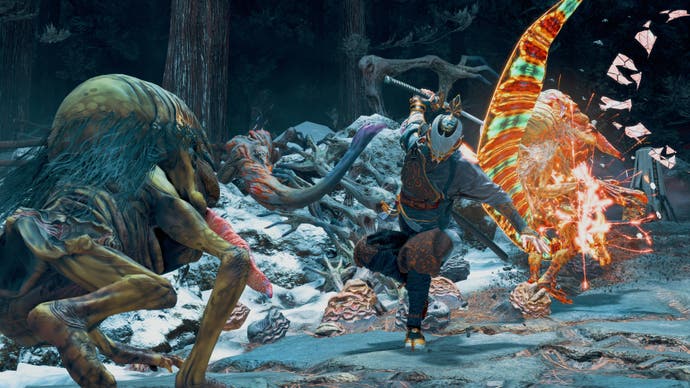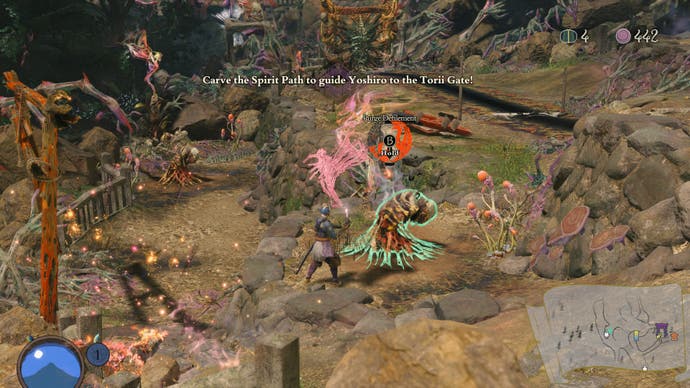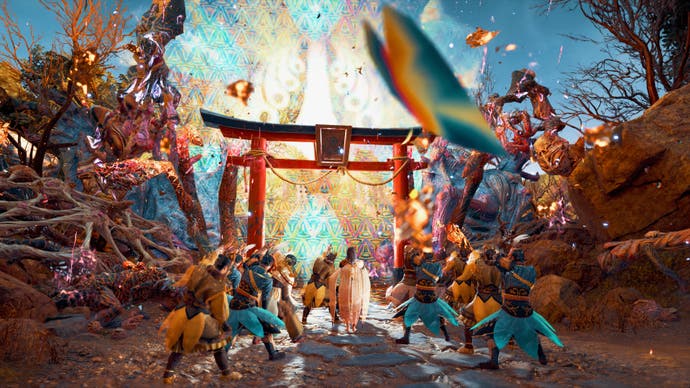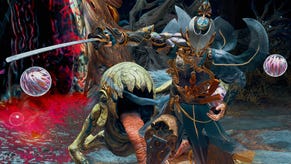Kunitsu-Gami: Path of the Goddess is a joyful, exuberant dance of strategic action
Monster mash.
Capcom and real-time strategy aren't words you'd normally put together, but if my first five hours with Kunitsu-Gami: Path of the Goddess are anything to go by, this is a match that's shaping up to be truly quite divine. This is a strategy game whose core is pure Capcom action, with energetic katana arcs and dazzling button combos laced with some of the most spectacular, kaleidoscopic visual effects this side of Okami (a connection that's not lost on Capcom either, thanks to their free Ammy and Waka costume crossover items coming at launch).
As Soh's sword careens through the air with his dance-like moveset, he leaves twisting trails of colour behind him, like he's constantly slicing through other dimensions that are just full of the brightest, most vibrant origami paper you've ever seen. It's a lovely little treat for repeatedly throwing yourself into the heat of battle, and it gives each level the kind of action-led exuberance you just don't get from strategy games where your main role is to simply direct your units from your skybox on high.
Don't get me wrong - there's still a Pikmin-like organisation layer to Kunitsu-Gami's midnight scraps, as alongside Soh you'll also need to free and enlist the help of each town's trapped villagers to help fend off the nightly waves of Japanese yokai monsters that come pouring through its numerous cursed torii gates. You get to decide what role (or class) they play and where best to place them, and you can also pause the action whenever you like if you need to redraw your plan of attack. But it's this marriage of cerebral supervision and corporeal button combos that just absolutely sings in Kunitsu-Gami so far, and I'm eager to see what else it has in store for me as I wind my way across this monster-filled mountaintop.

There are dozens of settlements to save on your journey of purification, and each one acts as a traditional level you need to complete before you can move on to the next one. They're often book-ended by separate boss fights with larger, almost Monster Hunter-sized adversaries, too, which really put your tactical nous to the test. Your goals usually come in three flavours - free all the villagers who have been cocooned in cursed, fleshy pods by the ravaging 'Seethe' monsters as they swept through the mountain, purge the village of all 'defilement' spots, and carve a Spirit Path for your priestess Yoshiro to follow so you can lead her to the village's main torii gate to cleanse it once and for all.
The path itself is fixed in each level, marked by an ominous black streak on the ground like it's been run through with an angry stroke of calligraphy ink. Later levels sometimes branch this path in different directions to add an extra layer of tactical thinking to the mix, but early on it acts as a single, on-rails track you have to manage and defend from the nightly monster waves. You get to control how far or how little Yoshiro moves across it, though, as carving a path with your sword requires spending crystals you've earned from each level, either by purifying the village during the day, or by defeating its yokai by night. Likewise, from what I've played so far, there aren't any time restrictions to complete levels in a certain number of day-night cycles either, giving you the freedom to approach each level as you please.
Sometimes, for example, it pays off to hold Yoshiro back a bit, even if you've got the crystals to push her along further toward your goal. A couple of levels in you get access to a carpenter who can help repair nets that can slow down the enemy advance, as well as buffing contraptions that enhance the attack power and movement speed of your nearby units. Advance Yoshiro too quickly, though, and you may not get the full benefit of these fixed gizmos, as each repair takes time to complete during your limited daylight hours. Similarly, there are special Spirit Ward platforms further on in the game that can act as a temporary Seethe shield to delay and thin their numbers even further, but only when Yoshiro's physically standing on it.


That's before we get to the whole business of deciding what units you're going to field as well, which so far range from melee woodcutters and tank-like sumo wrestlers to long-range archers and movement-binding ascetics. As you'd expect, each has their own strengths and weaknesses to consider, but again, nothing is set in stone here if you need to readjust. As long as you have the crystals, you can swap villager roles for something more advantageous if you suddenly find yourself assaulted from all angles by flying tongue spirits (archers all the way), or you need to halt the advance of bomb-like belly lads (ascetics ascetics ascetics).
There are also thieves you can employ to dig through the dirt for extra treasure during the day but who will scarper when the sun sets, leaving you a person down unless you cannily spend more crystals to change their role a second time before they leg it. And there are other obstructions you can get your villagers to help clear so you can reach those last few defiling carcass plants (eat your heart out, The Last of Us), or indeed a critical last villager pod. More powerful units cost more crystals, too, while others can only be taken on by certain villagers - denoted by certain animal stamps on the selection screen.

There's a lot to juggle in what always feels like a desperately short amount of downtime compared to your nightly fights (never have I felt the words 'daylight saving' so keenly here). I can't speak to the later levels just yet, but so far, at least, the pressure always feels just right to keep up the tension. My eyes are constantly scanning the densely packed trees and finger-like tendrils for more defilement spots to root out, and my brain is forever weighing up which contraptions to fix and how best to defend Yoshiro from multiple lines of attack. Will the Seethe come from this direction, or that direction? Let's put my archer here, my sumo there, and maybe I should leave a woodcutter in the rear just in case they sneak up from behind…
But even if I don't manage to make all the preparations I want to by the time the light fails, there's a part of me that also can't wait for those torii gates to burst open and for all hell to break loose. When those Seethe turn up, it is 100% go time, and I relish the moment when I can sprint Soh to the front lines, chasing down the hordes of waggling tongues, bony limbs, sunken eyes and bulbous jaw monsters while my very capable comrades pick up the slack behind me. Sure, there are times when I need to fall back and assist them, particularly on larger levels where multiple torii gates are spewing out Seethe at once, but for the most part they're pretty reliable, and they certainly don't need the kind of micro-managing that some AI party members do in other games I've played (looking at you, Ni No Kuni).



There are no doubt more efficient ways to dispatch these ghouls - as evidenced by the multitude of time-attack achievements that tempt you back for repeat playthroughs later on for extra upgrade treasures and trinkets to equip - but for now, I'm just enjoying the thrill of getting to see Soh's sword dance attacks in action (and repeatedly pausing mid sword-swing to get up close and personal with its really quite good photo mode, too). If Kunitsu-Gami can keep up the pace of this energetic tactical action in the second half of the game, this could be something really quite special indeed - and judging by the string of as-yet-unlocked villager classes I can see on my role docket dial, I really do hope this one's got the legs to sustain its so far wonderful sense of variety. Every level there's been a new monster to tackle, a new role to get to grips with, and a new scenario to rewire my brain (big shout out to the level that strips you of Soh completely in order to focus on learning how your carpenter's contraptions work properly), and I've loved every second of it. Here's hoping for an equally heavenly second half.







